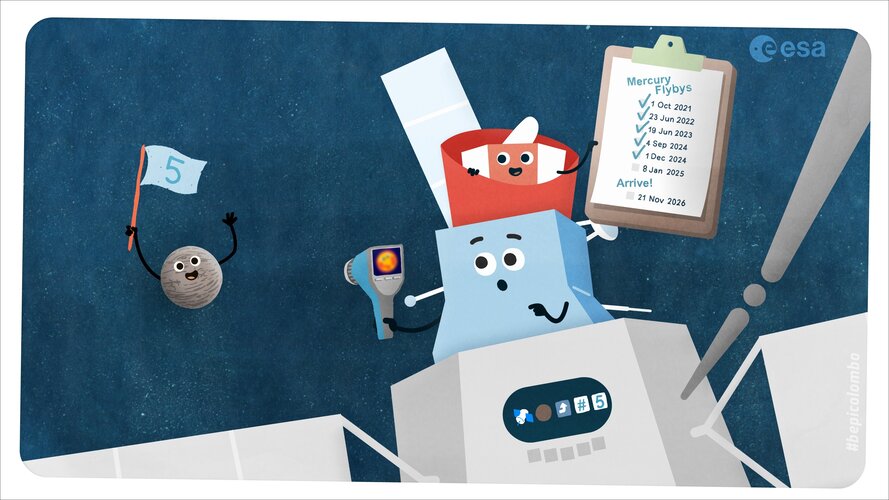
Copernical Team
Exolaunch to deploy 22 satellites on SpaceX Bandwagon-2 mission
 Exolaunch, a global leader in satellite deployment and mission integration, is gearing up for the Bandwagon-2 Rideshare mission with SpaceX. Following the success of the first Bandwagon mission earlier this year, the company will deploy 22 satellites into orbit for a diverse roster of international clients. Scheduled for no earlier than December 2024, the mission will launch from Vandenberg Spac
Exolaunch, a global leader in satellite deployment and mission integration, is gearing up for the Bandwagon-2 Rideshare mission with SpaceX. Following the success of the first Bandwagon mission earlier this year, the company will deploy 22 satellites into orbit for a diverse roster of international clients. Scheduled for no earlier than December 2024, the mission will launch from Vandenberg Spac ESA awards euro 34.6 million NanoMagSat contract to Open Cosmos
 The European Space Agency (ESA) has awarded a euro 34.6 million contract to Open Cosmos for the development, launch, and commissioning of the NanoMagSat Scout satellite constellation. This mission aims to enhance Europe's capabilities in monitoring Earth's magnetic field and advancing applications such as space weather assessment, navigation, and directional drilling.
The NanoMagSat missi
The European Space Agency (ESA) has awarded a euro 34.6 million contract to Open Cosmos for the development, launch, and commissioning of the NanoMagSat Scout satellite constellation. This mission aims to enhance Europe's capabilities in monitoring Earth's magnetic field and advancing applications such as space weather assessment, navigation, and directional drilling.
The NanoMagSat missi Eseye and Sateliot partner for global IoT across satellite and terrestrial networks
 Eseye, a leader in global IoT connectivity solutions, has partnered with Sateliot, a pioneer in satellite-based IoT networks, to deliver seamless 5G IoT connectivity by integrating terrestrial and satellite technologies. The collaboration leverages the latest 3GPP Release 17 (Rel.17) standard to provide uninterrupted connectivity through a single SIM solution, extending IoT coverage to areas wit
Eseye, a leader in global IoT connectivity solutions, has partnered with Sateliot, a pioneer in satellite-based IoT networks, to deliver seamless 5G IoT connectivity by integrating terrestrial and satellite technologies. The collaboration leverages the latest 3GPP Release 17 (Rel.17) standard to provide uninterrupted connectivity through a single SIM solution, extending IoT coverage to areas wit CubeSatGPT enables communication with orbiting satellites for education and research
 CubeSatGPT introduces a groundbreaking platform that allows users to interact directly with satellites and payloads launched by Vector Space Biosciences. Among the payloads, over 50 tardigrades (commonly known as waterbears) will be sent into orbit on CubeSats (nanosatellites).
These experiments will generate valuable datasets on microgravity and space radiation effects, transmitted back t
CubeSatGPT introduces a groundbreaking platform that allows users to interact directly with satellites and payloads launched by Vector Space Biosciences. Among the payloads, over 50 tardigrades (commonly known as waterbears) will be sent into orbit on CubeSats (nanosatellites).
These experiments will generate valuable datasets on microgravity and space radiation effects, transmitted back t Webb highlights spiral arms of galaxy NGC 2090 in infrared detail
 Featured in this month's image from the NASA/ESA/CSA James Webb Space Telescope is the spiral galaxy NGC 2090, situated in the constellation Columba. Using data from Webb's MIRI and NIRCam instruments, the image captures the galaxy's two elegant spiral arms and intricate patterns of gas and dust with unprecedented clarity.
Previously studied by the NASA/ESA Hubble Space Telescope to refine
Featured in this month's image from the NASA/ESA/CSA James Webb Space Telescope is the spiral galaxy NGC 2090, situated in the constellation Columba. Using data from Webb's MIRI and NIRCam instruments, the image captures the galaxy's two elegant spiral arms and intricate patterns of gas and dust with unprecedented clarity.
Previously studied by the NASA/ESA Hubble Space Telescope to refine Bepi, Mio and MTM greet Mercury for the fifth time
 Image:
Bepi, Mio and MTM greet Mercury for the fifth time
Image:
Bepi, Mio and MTM greet Mercury for the fifth time Proba-3: Not because it is easy…
 Video:
00:01:54
Video:
00:01:54
Not because it is easy but because it is hard: this historic space phrase is pretty much the definition of ESA’s double-satellite Proba-3 mission, which will employ precise formation flying to produce artificial total solar eclipses in orbit, casting a shadow from one spacecraft to the other. No-one has ever flown a mission like this, up until now. But just why is it so hard? Find out in this curtain-raising video trailer.
Proba-3 encapsulated
 Image:
Proba-3 encapsulated
Image:
Proba-3 encapsulated Ignis mission name and patch explained
 Video:
00:02:39
Video:
00:02:39
The Ignis mission, named after the Latin word for ‘fire,’ symbolises the spark igniting a new era in Poland’s space endeavours.
The central motif of the patch features an eagle – a reference to the emblem of Poland – in white and red, reflecting the colours and design of the Polish national flag. Its tail gracefully evokes a flame, while its outstretched wings trace the contours of the Orla Perć mountain range in the Polish Tatra Mountains. Within the mission’s name, the second ‘i’ takes the form of the International Space Station. Above it, stars converge to form the Scutum constellation, paying homage
Mars Ocean Analogs Completes Winter Solstice Voyage and Plans Future Expeditions
 The Mars Ocean Analogs (MOA) team has successfully concluded its Winter Solstice Voyage, an ambitious North Atlantic expedition that ran from November 15 to November 24. This marked MOA's fifth major sea-based analog mission, building on the momentum of previous high-profile voyages, including a notable journey to the SpaceX launch site near the U.S.-Mexico border.
Departing from Morris Ca
The Mars Ocean Analogs (MOA) team has successfully concluded its Winter Solstice Voyage, an ambitious North Atlantic expedition that ran from November 15 to November 24. This marked MOA's fifth major sea-based analog mission, building on the momentum of previous high-profile voyages, including a notable journey to the SpaceX launch site near the U.S.-Mexico border.
Departing from Morris Ca 































